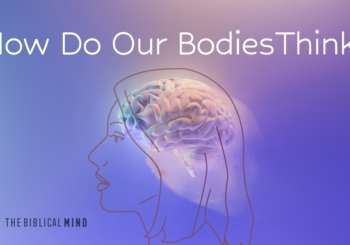Orality and the Cycle of Revelation: How God and His Image-Bearers Communicate
The world of biblical and mission study realized long ago that the Scriptures were more than a text. The Scriptures began with oral, visual, and sensorial communications. God spoke. Others received and shared his messages. These recipients wrote them down so that others could receive, understand, remember, and pass them on from generation to generation. As we will see, orality is our fundamental capacity to communicate with each other as those created in the image of God. It’s not about “oral vs. literate” or a particular method of sharing the Good News. Orality and the biblical text are inseparable.
Enjoying this article? Read more from The Biblical Mind.
To begin understanding this, picture a woman—call her Mary—browsing Amazon and clicking “buy now” on an ESV Bible. When it arrives in the mail, she opens to chapter 8 of Paul’s letter to the Romans. Then imagine that, in doing so, Mary accidentally opens some sort of magic portal. Suddenly, she sees a more distant scene where dozens of men and women celebrate their finished translation of her Bible. Next, she sees hecklers and inquisitors jeer William Tyndale for desecrating the Word of God by translating into English. Her translation came at the cost of the lives of Kingdom revolutionaries such as Tyndale and John Huss. The scene transforms again; she sees Roman Catholic monks sitting by candlelight as they painstakingly copy Greek and Latin versions of Paul’s letter. Back, back she travels in time, until she now sees a gathering of believers in Rome around the time of Nero. They’re in a house where a toga-clad man stands before the church speaking the letter to everyone, but it seems more like a performance than a reading.
The scene pivots to Paul in Corinth about to depart for Jerusalem. His hair is long and scraggly as he grows it out readying himself to perform a Nazarite vow when he reaches the Jewish temple. He’s putting things in order for the long trip back. The sack of coins on the table is the collection for famine relief— an offering to the apostles. Mary then sees another man, Tertius, writing down on a piece of parchment every word Paul speaks.
Finally, Mary begins hearing whisperings—they are coming from Paul’s head. It’s the Holy Spirit prompting Paul in what to say. Now she stands awestruck and trembling. She is in the Prescence—the Throne Room of God! His voice is saying, “I love you. Nothing will ever separate you from my overwhelming conquering love!”
This is not just an allegory, but a description of what the Scriptures are and how we got them. The Scriptures in our hands come from of the mind of God (I Cor 2, Heb 1:1–4). Let’s begin by considering the mind and nature of God—not the Bible itself, but more how he revealed himself to us. Ultimately God’s own revelation relates to how we communicate the Word as those made in his image so that others may personally know his mind, his heart, and his love.
Orality as the Divine Capacity for Inner Speech1For a more in-depth discussion of orality visit the Institutes for Orality Strategies website. Study the biblical roots of orality, the characteristics and tendencies of how people function using orality, and the ways and means Jesus learned to communicate what his father commanded him to teach and how to say it (Jn 12:48–49).
Before the beginning, God is and is in three persons. No human can fathom that truth, but somehow, we reflect it as creatures made in his image. At some “time” before this finite universe existed, God intricately planned a species capable of living with him and choosing to love him as he loved them. Yet before the Word spoke all this into existence, the Father, Spirit, and Son contemplated what that meant: rejection of his love, and redemption for those who might choose to return to live under his authority. The Scriptures unfold that plan from their stated beginnings of Genesis to the climactic story foretold as the new beginnings of Revelation 21–22.
So, the Bible is a witness to our microscopic glimpse into the mind of God, and all that we can learn of him finds its grounding only in that Word. He in some way reveals that infinite mind and expansive love to his beloved family of Eve and Adam. Yet, many of our closed suppositions regarding the Bible and God’s revelation of his mind see the Scriptures as the Word of God and an end in themselves. That suggests that we can only know his mind as we accurately translate and interpret the Hebrew, Aramaic, and Greek surviving texts that scribes faithfully handed down to the best of their abilities. This self-revealing God is much greater than that, so let’s consider more closely how he communicates.
God, the Communicator
He created us in his image to communicate like our Father. It all begins with what we call our thoughts, which Lev Vygotsky calls “inner speech.” God expressed his inner speech in some way among the Godhead then spoke the world into existence. He made things each day and named them. He later expressed his inner speech by talking with Adam and Eve in their intimate garden discussions in the cool of the evenings. He painted his glory in the heavens and earth, and even communicated through the revelation seen and eventually touched, the focal point of the garden: two trees.
Think of all the other ways God historically communicated his thoughts to his children. He audibly spoke to Noah and then to Abraham. He physically appeared at the tent of Abraham announcing the promised son as well as the destruction of Sodom and Gomorrah’s blight on creation. He appeared in visions to Isaac, Jacob, and Joseph. He appeared in a burning bush to Moses. He came as a pillar of smoke and fire to the “Exodites.” He commissioned an earthly representation of his presence with an arts galleria called a tabernacle—from the outer skins to the mercy seat in the Holy of Holies. He engraved stone tablets and wrote on walls. He spoke in proverbs and riddles, ordained symbols, metaphors, acting, songs, dances, feasts and meals, beautiful and holy garments, clothing accessories, sacrifices, scents of incense, perfumes, and special oils, and the list continues.
As children in His image, we also share His capacities for communication through all five senses. You can influence others’ thoughts and imaginations through various forms of expression. You can make up proverbs, compose songs and dances, and speak expecting some kind of action—sharing your inner speech with others.
Spoken by the Holy Spirit to prophets (I Peter 1:21; I Cor 2:10–16). The mind and thoughts of God the Father came to those chosen to receive and speak his Word and to make clear his will and counsel. So, in terms of the present discussion, the inner speech of God the Father came to prophets and apostles (such as Paul, John, Peter, and all who might receive a “word of knowledge” given in extra-biblical revelations).
Received in community. God, who dwells in divine community, reveals his mind to and through individuals commissioning them to share it with a widening circle of communities. The Law was given for all Israel. He expected them to etch that Law into every fiber of every family in this emerging culture. Moses took that family history to its genesis so that Israel and all nations/peoples of the earth could know and worship God alone. He carved out a homeland for the sons of Jacob and commanded them to live as a kingdom of priests for the nations.
Later he communicated to entire churches. Whole Christian communities of Thessalonica, Rome, Corinth, in Galatia, Ephesus, and Philippi. The inner speech of God now became the inner speech of his children to produce God’s intended results. Sometimes it resulted in belief and repentance (Acts 2). Sometimes it was for encouragement of those under great pressure (Timothy and Titus, Hebrews, I Peter, Revelation).
Made permanent into written forms. Jeremiah and his scribe Baruch eventually wrote down all the inspired messages delivered to the weeping prophet. In at least one case he spoke the word to a king who rejected the message (Jer 36). Then Baruch put the message in writing for the king and his court. The king proceeded to burn the scroll, so Jeremiah told Baruch to write it out again and deliver it to the king a second time. As further documentation, royal court historians in the Davidic ancestral dynasty even produced a record of all the God-given stories then recorded in the Annals of the Kings (2 Kings 1:18).
God commanded Moses to write down his warnings and teach them to Israel in a song. John recorded the words of Jesus yet acknowledged that much more could have been written. The angel of Revelation instructs John to “write these words” and deliver them to the seven churches of Asia. Recording the mind of God in a more permanent mode accurately preserved it for future generations to speak aloud over and over.
Duplicated for generations of new churches among all peoples and all times. Even as Paul sent words to the Christians living in regions of Colossae and Ephesus, he intended the message to spread through circulation of the letters. At each stop on the circuit, it would be inconceivable to think that the letters were not immediately copied and read/performed to all the believers in every city. It was a common practice that Paul may have expected Timothy to do publicly, and later to bring his “books and parchments.”
Secured in an agreed-upon canon for posterity. Collections of all the inspired revelations of the Law and the Prophets culminated a few centuries after the death of John. The Hebrew Scriptures were not even universally accepted in the days of Jesus outside of the Torah and a few prophets, as the Sadducees insisted. But eventually a series of Western church councils weighed in on what writings they believed carried divine authority and apostolic connections. You hold in your hands or on your screen the fruit of their labor—the canon of Scripture.
A Broader Concept of God’s Word
Orality is about communication—how we reach shared understanding of our realities. It comprises everything that we are as God-stamped children made in his image. Orality is about all of who we are and how we develop into adults with every joy and nightmare that comes down our road, and the way that shapes how and what we communicate.
God’s messages came to the prophets and then were communicated to others teaching God’s children. Then, they were condensed to writing. In this cycle of revelation, eventually the average person with sufficient literacy (only 20 percent of the world) could access those print-text versions of God’s recorded inner speech. But how will the rest of the non-literate, high orality-reliant world receive it? Process it? Remember it? Pass it on to others? These questions should haunt all Western Christians, who have seemingly unlimited access to the Scriptures.
Is orality in conflict with Biblical texts? Not in any way. The text of Scripture remains our plumb line for all truth and revelation. At the same time, it must be repeated: the oral transmission of the mind and heart of God preceded the text. It always has, and always will. Further, textual performance loses significant parts of a message. Inflection, tone, volume, and body language all contribute to meaning, which is maybe partly why God commanded the Scriptures be delivered in collective settings—publicly and in families. New Testament writers even included the words of first century hymns and poems that we now regard as inspired. They are part of the text! The text of Scripture confirms the revealed mind of God to be personally passed on generation after generation (Deut 6; 2 Tim 2:1–2).
If we believe the Bible is the mind of God for all his children of Adam’s race, we stand accountable to deliver it to those who remain in darkness. They live without God and without hope in this world (Eph 2:12). Orality is not an argument for “oral evangelism methods.” Orality stands as a witness shouting that 80 percent of the world cannot receive the word of God because of our learned and preferred methods of print-text-based communication.
Our fictitious “Mary” was transported into a timeless reality. Her relationship with God changed that morning. The way she read the Bible changed. He spoke the word to her. Her discussions of the Scriptures in her discipleship group changed. God was speaking to and through them. She could no longer ignore those “without God and without hope in the world.” She can help others translate it into oral forms, send it, and support other servants who can and will share it.
For a more in-depth discussion of orality visit the Institutes for Orality Strategies website
End Notes
1. For a more in-depth discussion of orality visit the Institutes for Orality Strategies website. Study the biblical roots of orality, the characteristics and tendencies of how people function using orality, and the ways and means Jesus learned to communicate what his father commanded him to teach and how to say it (Jn 12:48–49).
Other Bibliography:
Madinger, Charles and Rocelyn Anog Madinger. “Unleashing the Power of Orality, Myth, and Folklore.” In, Voices from the Margins: The Wisdom of Primal Peoples in the Era of World Christianity. Edited by David Smith and Jangkhlam Haokin. Carlisle, UK: Langham Publishing, 2022.
—”Orality in Asia: Advancing Unprecedented Kingdom Growth.” Asian Missions Advance (January 2022).
Ong, Walter. Orality and Literacy: The Technologizing of the Word. London: Methuen, 1982.
Van De Veer, Rene. Lev Vygotsky. Bloomsbury Library of Educational Thought. Edited by Richard Bailey. London: Bloomsbury Publishing, October, 23, 2014.
Image created by Rubner Durais
Did you enjoy this article? Check out The Biblical Mind podcast.





